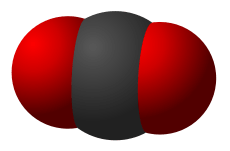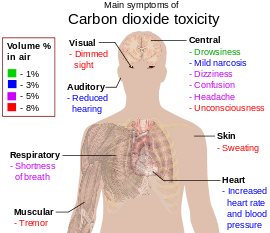Hypercapnia
| Hypercapnia | |
|---|---|
 | |
| Classification and external resources | |
| ICD-10 | R06.8 |
| ICD-9 | 786.09 |
| DiseasesDB | 95 |
| MeSH | D006935 |
Hypercapnia or hypercapnea (from the Greek hyper = "above" or "too much" and kapnos = "smoke"), also known as hypercarbia, is a condition of abnormally elevated carbon dioxide (CO2) levels in the blood. Carbon dioxide is a gaseous product of the body's metabolism and is normally expelled through the lungs.
Hypercapnia normally triggers a reflex which increases breathing and access to oxygen, such as arousal and turning the head during sleep. A failure of this reflex can be fatal, for example as a contributory factor in sudden infant death syndrome.[1]
Hypercapnia is the opposite of hypocapnia, the state of having abnormally reduced levels of carbon dioxide in the blood.
Causes
Hypercapnia is generally caused by hypoventilation, lung disease, or diminished consciousness. It may also be caused by exposure to environments containing abnormally high concentrations of carbon dioxide (usually due to volcanic or geothermal causes), or by rebreathing exhaled carbon dioxide. It can also be an initial effect of administering supplemental oxygen on a patient with sleep apnea. In this situation the hypercapnia can also be accompanied by respiratory acidosis.[2]
Symptoms and signs

Symptoms and signs of early hypercapnia include flushed skin, full pulse, tachypnea, dyspnea, extrasystoles, muscle twitches, hand flaps, reduced neural activity, and possibly a raised blood pressure. According to other sources, symptoms of mild hypercapnia might include headache, confusion and lethargy. Hypercapnia can induce increased cardiac output, an elevation in arterial blood pressure, and a propensity toward arrhythmias.[5][6] In severe hypercapnia (generally PaCO2 greater than 10 kPa or 75 mmHg), symptomatology progresses to disorientation, panic, hyperventilation, convulsions, unconsciousness, and eventually death.[7][8]
Laboratory values
Hypercapnia is generally defined as a blood gas carbon dioxide level over 45 mmHg. Since carbon dioxide is in equilibrium with carbonic acid in the blood, hypercapnia can drive serum pH down, resulting in a respiratory acidosis. Clinically, the effect of hypercapnia on pH is estimated using the ratio of the arterial pressure of carbon dioxide to the concentration of bicarbonate ion, PaCO2/[HCO3−].
Tolerance
| %CO2 in inspired air | Expected tolerance for useful activity on continued exposure to elevated CO2 | |
|---|---|---|
| Duration | Major limitation | |
| 0.04 | lifetime | normal atmosphere |
| 0.5 | lifetime | no detectable limitations |
| 1.0 | lifetime | |
| 1.5 | < 1 month | mild respiratory stimulation |
| 2.0 | < 1 month | |
| 2.5 | < 1 month | |
| 3.0 | < 1 month | moderate respiratory stimulation |
| 3.5 | < 1 week | |
| 4.0 | < 1 week | moderate respiratory stimulation, exaggerated respiratory response to exercise |
| 4.5 | < 8 hours | |
| 5.0 | < 4 hours | prominent respiratory stimulus, exaggerated respiratory response to exercise |
| 5.5 | < 1 hours | |
| 6.0 | < 0.5 hours | prominent respiratory stimulus, exaggerated respiratory response to exercise, beginnings of mental confusion |
| 6.5 | < 0.25 hours | |
| 7.0 | < 0.1 hours | limitation by dyspnea and mental confusion |
During diving
Normal respiration in divers results in alveolar hypoventilation resulting in inadequate CO2 elimination or hypercapnia. Lanphier's work at the US Navy Experimental Diving Unit answered the question "why don't divers breathe enough?":[9]
- Higher inspired oxygen (PiO2) at 4 atm (400 kPa) accounted for not more than 25% of the elevation in end tidal CO2 (etCO2)[10] above values found at the same work rate when breathing air just below the surface.[11][12][13][14]
- Increased work of breathing accounted for most of the elevation of PACO2 (alveolar gas equation) in exposures above 1 atm (100 kPa), as indicated by the results when helium was substituted for nitrogen at 4 atm (400 kPa).[11][12][13][14]
- Inadequate ventilatory response to exertion was indicated by the fact that, despite resting values in the normal range, PetCO2 rose markedly with exertion even when the divers breathed air at a depth of only a few feet.[11][12][13][14]
Additional sources of carbon dioxide in diving
There is a variety of reasons for carbon dioxide not being expelled completely when the diver exhales:
- The diver is exhaling into a vessel that does not allow all the CO2 to escape to the environment, such as a long snorkel, full face diving mask, or diving helmet, and the diver then re-inhales from that vessel, causing increased deadspace.[14]
- The carbon dioxide scrubber in the diver's rebreather is failing to remove sufficient carbon dioxide from the loop (Higher inspired CO2).
- The diver is over-exercising, producing excess carbon dioxide due to elevated metabolic activity.
- The density of the breathing gas is higher at depth, so the effort required to fully inhale and exhale has increased, making breathing more difficult and less efficient (Work of breathing).[9] The higher gas density also causes gas mixing within the lung to be less efficient, thus increasing the deadspace (wasted breathing).[14]
- The diver is deliberately hypoventilating, known as "skip breathing" (see below).
Skip breathing
Skip breathing is a controversial technique to conserve breathing gas when using open-circuit scuba, which consists of briefly holding one's breath between inhalation and exhalation (i.e., "skipping" a breath). It leads to CO2 not being exhaled efficiently.[15] There is also an increased risk of burst lung from holding the breath while ascending. It is counterproductive with a rebreather, where the act of breathing pumps the gas around the "loop", pushing carbon dioxide through the scrubber and mixing freshly injected oxygen.
Rebreathers
In closed circuit SCUBA (rebreather) diving, exhaled carbon dioxide must be removed from the breathing system, usually by a scrubber containing a solid chemical compound with a high affinity for CO2, such as soda lime.[16] If not removed from the system, it may be re-inhaled, causing an increase in the inhaled concentration.
MRI
The hypercapnic state is routinely used to calibrate blood-oxygen-level dependent functional magnetic resonance imaging (BOLD fMRI), a modality that is sensitive to changes in blood oxygenation. However, this calibration crucially relies on the assumption that hypercapnia has no effect on neuronal function, which is a matter of debate.[17]
See also
- Inert gas asphyxiation
- Lake Nyos
- Respiratory Physiology
- Hypocapnia, decreased level of carbon dioxide
- Ocean acidification
- Permissive hypercapnia
- Sleep apnea
- Water boarding
References
- ↑ Kinney, Hannah C; Thach, Bradley T (2009). "The sudden infant death syndrome". The New England Journal of Medicine 361 (8): 795–805. doi:10.1056/NEJMra0803836. PMC 3268262. PMID 19692691.
- ↑ Dement, Roth, Kryger, 'Principles & Practices of Sleep Medicine' 3rd edition, 2000, p. 887.
- ↑ Toxicity of Carbon Dioxide Gas Exposure, CO2 Poisoning Symptoms, Carbon Dioxide Exposure Limits, and Links to Toxic Gas Testing Procedures By Daniel Friedman – InspectAPedia
- ↑ Davidson, Clive. 7 February 2003. "Marine Notice: Carbon Dioxide: Health Hazard". Australian Maritime Safety Authority.
- ↑ Stapczynski J. S, "Chapter 62. Respiratory Distress" (Chapter). Tintinalli JE, Kelen GD, Stapczynski JS, Ma OJ, Cline DM: Tintinalli's Emergency Medicine: A Comprehensive Study Guide, 6th Edition: http://www.accessmedicine.com/content.aspx?aID=591330.
- ↑ Morgan GE, Jr., Mikhail MS, Murray MJ, "Chapter 3. Breathing Systems" (Chapter). Morgan GE, Jr., Mikhail MS, Murray MJ: Clinical Anesthesiology, 4th Edition: http://www.accessmedicine.com/content.aspx?aID=886013.
- ↑ 7.0 7.1 Lambertsen, Christian J. (1971). "Carbon Dioxide Tolerance and Toxicity". Environmental Biomedical Stress Data Center, Institute for Environmental Medicine, University of Pennsylvania Medical Center (Philadelphia, PA). IFEM Report No. 2–71. Retrieved 2008-06-10.
- ↑ Glatte Jr H. A., Motsay G. J., Welch B. E. (1967). "Carbon Dioxide Tolerance Studies". Brooks AFB, TX School of Aerospace Medicine Technical Report. SAM-TR-67-77. Retrieved 2008-06-10.
- ↑ 9.0 9.1 US Navy Diving Manual, 6th revision. United States: US Naval Sea Systems Command. 2006. Retrieved 2008-06-10.
- ↑ etCO2 is defined as he level of (partial pressure of) carbon dioxide released at end of expiration
- ↑ 11.0 11.1 11.2 Lanphier, EH (1955). "Nitrogen-Oxygen Mixture Physiology, Phases 1 and 2". US Navy Experimental Diving Unit Technical Report. AD0784151. Retrieved 2008-06-10.
- ↑ 12.0 12.1 12.2 Lanphier EH, Lambertsen CJ, Funderburk LR (1956). "Nitrogen-Oxygen Mixture Physiology – Phase 3. End-Tidal Gas Sampling System. Carbon Dioxide Regulation in Divers. Carbon Dioxide Sensitivity Tests". US Navy Experimental Diving Unit Technical Report. AD0728247. Retrieved 2008-06-10.
- ↑ 13.0 13.1 13.2 Lanphier EH (1958). "Nitrogen-oxygen mixture physiology. Phase 4. Carbon Dioxide sensitivity as a potential means of personnel selection. Phase 6. Carbon Dioxide regulation under diving conditions". US Navy Experimental Diving Unit Technical Report. AD0206734. Retrieved 2008-06-10.
- ↑ 14.0 14.1 14.2 14.3 14.4 Lanphier EH (1956). "Nitrogen-Oxygen Mixture Physiology. Phase 5. Added Respiratory Dead Space (Value in Personnel Selection tests) (Physiological Effects Under Diving Conditions)". US Navy Experimental Diving Unit Technical Report. AD0725851. Retrieved 2008-06-10.
- ↑ Cheshire, William P; Ott, Michael C (2001). "Headache in Divers". Headache: The Journal of Head and Face Pain 41 (3): 235–247. doi:10.1046/j.1526-4610.2001.111006235.x. PMID 11264683.
Carbon dioxide can accumulate insidiously in the diver who intentionally holds the breath intermittently (skip breathing) in a mistaken attempt to conserve air
- ↑ Richardson, Drew; Menduno, Michael; Shreeves, Karl (eds). (1996). "Proceedings of Rebreather Forum 2.0.". Diving Science and Technology Workshop.: 286. Retrieved 2009-05-16.
- ↑ Ing, Alex; Schwarzbauer, Christian (6 June 2014). "Cluster Size Statistic and Cluster Mass Statistic: Two Novel Methods for Identifying Changes in Functional Connectivity Between Groups or Conditions". PLoS One. doi:10.1371/journal.pone.0098697.
| ||||||||||||||||||||||||||||||||||||
| |||||||||||||||||||||||||||||||||||||||||||||||||||||||

